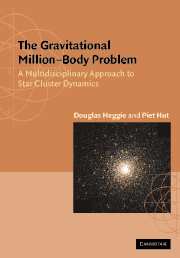Book contents
- Frontmatter
- Contents
- Preface
- PART I INTRODUCTIONS
- PART II THE CONTINUUM LIMIT: N → ∞
- PART III MEAN FIELD DYNAMICS: N = 106
- PART IV MICROPHYSICS: N = 2
- PART V GRAVOTHERMODYNAMICS: N = 106
- PART VI GRAVITATIONAL SCATTERING: N = 3
- PART VII PRIMORDIAL BINARIES: N = 4
- PART VIII POST-COLLAPSE EVOLUTION: N = 106
- PART IX STAR CLUSTER ECOLOGY
- 30 Stellar and Dynamical Evolution
- 31 Collisions and Capture
- 32 Binary Star Evolution and Blue Stragglers
- 33 Star Cluster Evolution
- Appendix A A Simple N-Body Integrator
- Appendix B Hints to Solution of Problems
- References
- Index
32 - Binary Star Evolution and Blue Stragglers
Published online by Cambridge University Press: 05 June 2012
- Frontmatter
- Contents
- Preface
- PART I INTRODUCTIONS
- PART II THE CONTINUUM LIMIT: N → ∞
- PART III MEAN FIELD DYNAMICS: N = 106
- PART IV MICROPHYSICS: N = 2
- PART V GRAVOTHERMODYNAMICS: N = 106
- PART VI GRAVITATIONAL SCATTERING: N = 3
- PART VII PRIMORDIAL BINARIES: N = 4
- PART VIII POST-COLLAPSE EVOLUTION: N = 106
- PART IX STAR CLUSTER ECOLOGY
- 30 Stellar and Dynamical Evolution
- 31 Collisions and Capture
- 32 Binary Star Evolution and Blue Stragglers
- 33 Star Cluster Evolution
- Appendix A A Simple N-Body Integrator
- Appendix B Hints to Solution of Problems
- References
- Index
Summary
Once thought to be virtually devoid of binaries, globular clusters are now known to contain binaries in abundances not very much less than that of the galactic disk. Binaries in such large numbers, containing at least ten per cent of the stars in a typical globular cluster, cannot have resulted from dynamical interactions, and therefore must have formed at the same time that the bulk of the stars were formed. With so many binary stars around, all kinds of interesting reaction channels are possible, in three-body as well as four-body interactions. Binaries containing pulsars are just one example of the unusual objects that can result.
Even without dynamical interactions with other objects, binary star evolution in isolation is quite complicated enough. Compared to the evolution of single stars, a wide variety of new kinds of binaries and single stars can be created, through mass overflow from one star to the other, or through mass loss from the system, at various stages in their combined evolution. The stars can form a common envelope for a while, or one of the stars can explode as a supernova. Even if the explosion is symmetric the binary might not survive, as in the impulsive loss of mass in any stellar system (Chapter 11). Disruption is even more likely if the remnant receives a ‘kick’ (see Hills 1983), and if you find a neutron star in a binary in a star cluster it is likely to have got there by dynamical interactions (e.g. Kalogera 1996).
- Type
- Chapter
- Information
- The Gravitational Million–Body ProblemA Multidisciplinary Approach to Star Cluster Dynamics, pp. 291 - 297Publisher: Cambridge University PressPrint publication year: 2003

